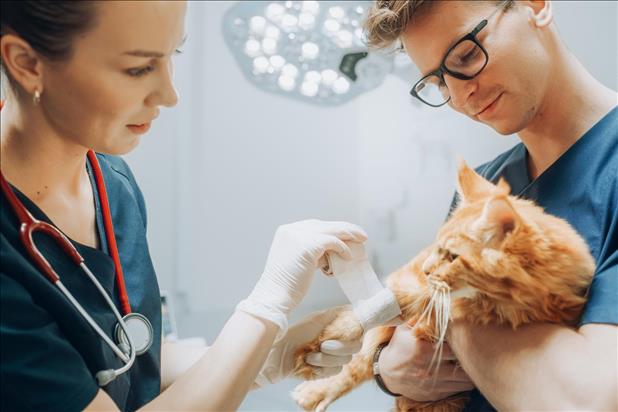- Employer Resources
- |
- Last Updated: April 16, 2025

Veterinary Industry Hiring and Talent Retention Trends for 2025
The veterinary industry is poised for a period of strong growth in 2025 and beyond. That means employers will have to compete for top talent amid an ongoing veterinary shortage. Whether you manage a corporate chain, neighborhood office, zoo, or research lab, finding and retaining high-quality staff has become more difficult in recent years due to a pandemic-driven boom in pet ownership.
To stand apart in a crowded market, it’s important to take note of these key veterinary employment trends.
Increased Demand for Services Is Driving Up Wages
More than one in five Americans adopted a pet during the COVID-19 pandemic, which may be one factor driving the increase in demand for veterinary services. According to the Bureau of Labor Statistics, the number of veterinarian jobs is on pace to increase by nearly a fifth between 2023 and 2033. That’s significantly faster than the average growth rate in the overall labor market.
To compensate for this increased demand, you’ll need to increase your average veterinarian salaries to stay competitive. The Bureau of Labor Statistics shows a median salary of $119,100 per year (or about $57 per hour) for 2023, the latest year data is available. Keep in mind that roughly half of all veterinarians earn more than this figure. That means you may need to offer higher salaries to attract top talent.
It’s also important to remember that these figures reflect nationwide averages. Veterinary clinics located in high-cost-of-living areas, like New York City or Los Angeles, may need to offer higher wages to meet prevailing market conditions. It’s a good idea to use free online resources like iHire’s salary research tools to get a feel for your local job market.
Offering wages above the local median can help you save money over the long haul by boosting retention. Remember, replacing an employee costs, on average, one and a half to two times their wages. Paying an above-average salary is a good way to mitigate this concern and overcome the ongoing veterinarian shortage.
Mental Health Challenges and Burnout Remain a Top Concern
Burnout is an ever-present risk for veterinarians. According to the National Institutes of Health, roughly half of all veterinarians report feeling moderate to severe levels of burnout, and a large number screen positive for depression. Aside from the all-too-real costs to your staff’s well-being and productivity, burnout can also contribute to decreased retention, and a poor reputation for work-life balance may deter well-qualified hires from joining your practice.
It’s imperative that veterinary clinics work proactively to prevent burnout. Taking steps like offering flexible working hours, more paid time off, and employer-sponsored wellness programs can help you stay ahead of the curve on this important issue. Going above and beyond by offering company-sponsored sabbaticals, streamlined access to talk therapy, and accessible mental health services like telehealth apps can go a long way toward attracting and retaining high-quality talent.
Telemedicine Is Changing the Way Veterinarians Work
In the wake of the COVID-19 pandemic, telemedicine has become increasingly prevalent in veterinarian practices. This shift presents both challenges and opportunities for veterinary clinics looking to attract well-qualified staff. Clinics can use telemedicine as a bargaining chip for veterinarians in search of less demanding schedules and greater flexibility. Depending on clinic size and local demand, you may be able to offer a hybrid work schedule.
Not only is this a great strategy to entice and retain qualified workers in a hot labor market, but it can even contribute to your bottom line. Many employees are willing to work for less in exchange for remote or hybrid schedules. According to the National Bureau of Economic Research, employees are willing to accept 25% less for a remote or hybrid role over one that requires five days of in-person attendance per week.

Clinics Need to Work Hard to Attract Specialized Talent
A recent study by the American Association of Veterinary Medical Colleges (AAVMC) suggests that demand for specialized veterinary services will continue to grow through at least 2032. Pet owners are increasingly willing to shell out large sums of money to improve their pets’ quality of life and treat life-threatening conditions like cancer and organ failure. To meet this demand, clinics need to offer strong compensation packages to attract and retain qualified specialists like ophthalmologists, surgeons, and dentists.
Of course, providing a competitive salary and benefits package is just one piece of the puzzle. Retaining top-tier talent also requires fostering a positive working environment and an employee-centered company culture.
Corporate Consolidation Poses a Risk to Smaller Clinics
Private equity has continued to flow into the veterinary industry, leading to a wave of mergers and acquisitions as well as strong growth in chain-owned veterinary hospitals. This trend presents a significant obstacle for smaller clinics trying to succeed in an increasingly crowded marketplace.
Large chain hospitals have a leg up over smaller clinics because economies of scale and access to inexpensive funding allow them to offer higher wages.
Reach Qualified Vet Pros for Your Team
Create your free account to get started!

We Value Your Privacy
Pet Insurance Consolidation May Squeeze Payouts
In a similar vein, the pet insurance industry has seen a wave of consolidation that may signal near-term struggles for clinics looking to negotiate payouts. JAB Holding Company now owns more than 20 pet insurance brands across its subsidiaries. This could mean increased pressure to standardize payments for specific services, potentially leading to lower margins for animal hospitals.
Although ongoing industry trends pose potential difficulties for veterinary clinics looking to hire and retain top talent, there are a few silver linings hidden among the clouds. Increased demand for veterinary services creates a strong business environment, even with rising overhead. And while industry consolidation can lead to stiffer competition, it can also drive greater standardization and improved best practices across the field.
With iHireVeterinary’s industry-focused approach to hiring, you can overcome these challenges and reach the right talent. Post your jobs or search our resume database today to get started.
RELATED RESOURCES
Hiring? You're in the Right Place.
- Reach unique talent: 51% of our candidates aren't using other job boards
- Connect your ATS and get 6x more applications with iHire's apply process
- Get matching candidate resumes sent straight to your inbox
We Value Your Privacy




